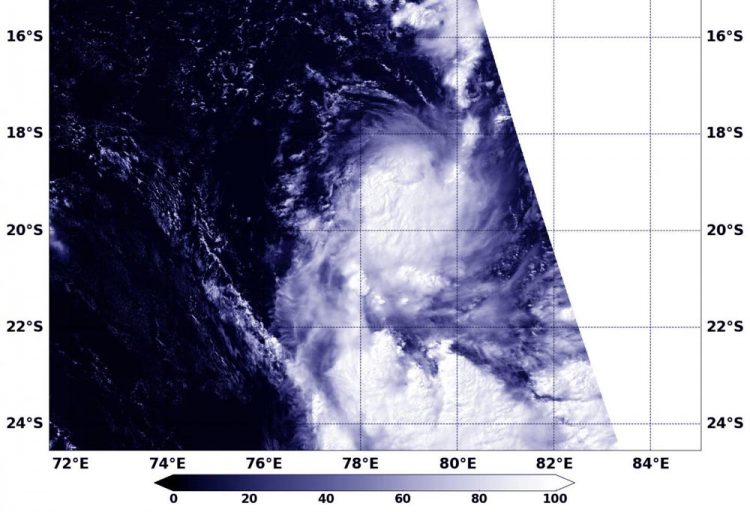NASA sees Tropical Cyclone 17S form

NASA's Terra satellite captured an image of the birth of Tropical Cyclone 17S in the Southern Indian Ocean on March 29. Credits: NASA/NRL
The storm formed on March 28 around 2100 UTC (5 p.m. EDT) and strengthened into a tropical storm. At 0900 UTC (5 a.m. EDT), Tropical cyclone 17S's maximum sustained winds were near 40 knots (46 mph/74 kph).
It was located near 17.8 degrees south latitude and 78.3 degrees east longitude, about 726 nautical miles south-southeast of Diego Garcia. It was moving to the south at 15 knots (17.2 mph/27.7 kph).
When NASA's Terra satellite passed over the storm the Moderate Resolution Imaging Spectroradiometer instrument aboard captured a visible image showing a slightly elongated storm with wind shear pushing clouds south of the well- defined low-level center.
The Joint Typhoon Warning Center forecast calls for 17S to continue moving south and maintain current strength. After two days, adverse conditions are expected to lead to its demise as dry air approaches the system.
Media Contact
All latest news from the category: Earth Sciences
Earth Sciences (also referred to as Geosciences), which deals with basic issues surrounding our planet, plays a vital role in the area of energy and raw materials supply.
Earth Sciences comprises subjects such as geology, geography, geological informatics, paleontology, mineralogy, petrography, crystallography, geophysics, geodesy, glaciology, cartography, photogrammetry, meteorology and seismology, early-warning systems, earthquake research and polar research.
Newest articles

Superradiant atoms could push the boundaries of how precisely time can be measured
Superradiant atoms can help us measure time more precisely than ever. In a new study, researchers from the University of Copenhagen present a new method for measuring the time interval,…

Ion thermoelectric conversion devices for near room temperature
The electrode sheet of the thermoelectric device consists of ionic hydrogel, which is sandwiched between the electrodes to form, and the Prussian blue on the electrode undergoes a redox reaction…

Zap Energy achieves 37-million-degree temperatures in a compact device
New publication reports record electron temperatures for a small-scale, sheared-flow-stabilized Z-pinch fusion device. In the nine decades since humans first produced fusion reactions, only a few fusion technologies have demonstrated…





















